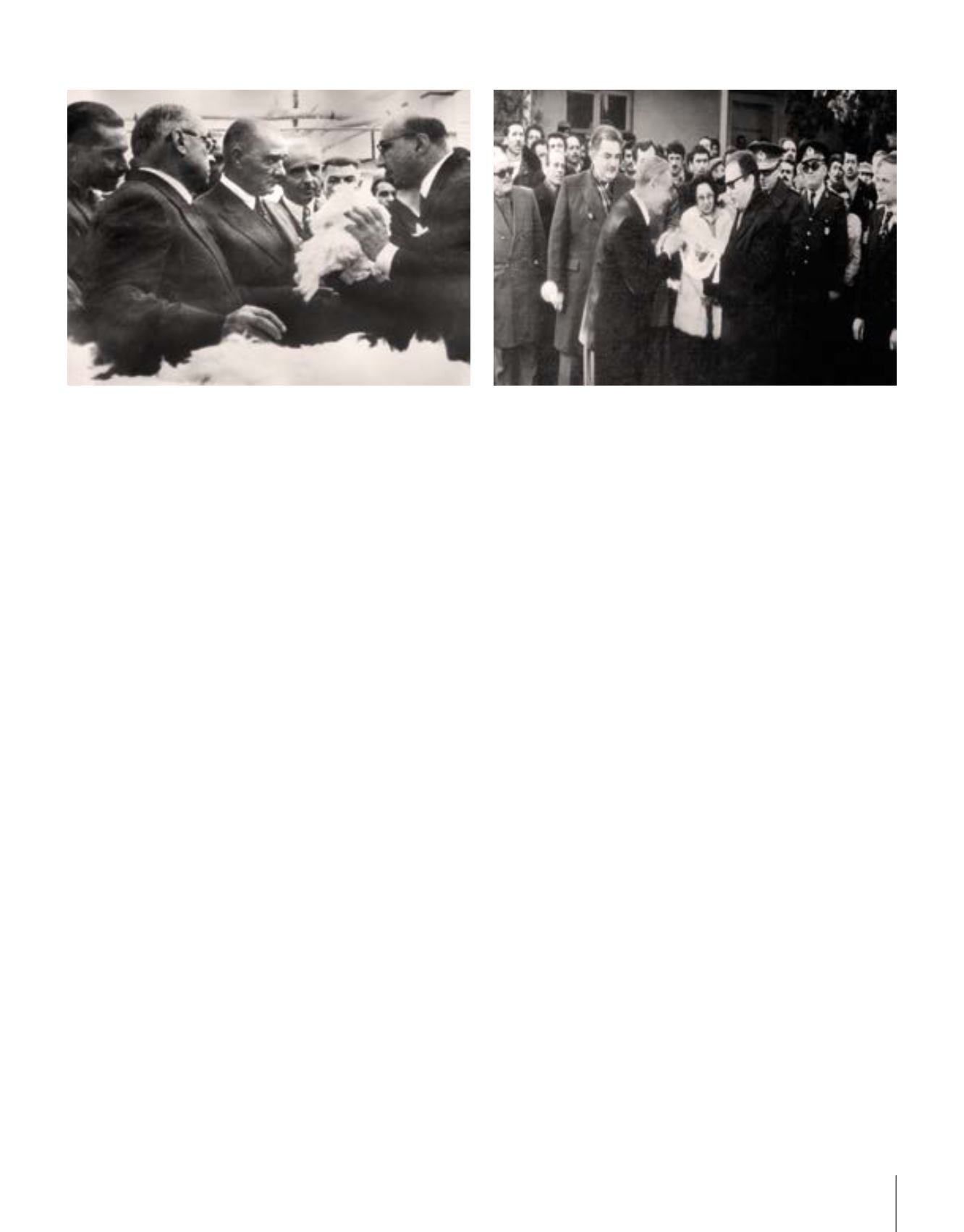
39
Sümerbank Nazilli Fabrika açılışında Müdür Fazlı Turga, Atatürk, İsmet İnönü ve
Celal Bayar’a bilgi veriyor, 1937 (Merinos Tekstil ve Sanayi Müzesi)
Merinos Fabrika Müdürü Ali Rıza Sünnetçioğlu, Teknik Müdür Birol Dorken,
Sümerbank Genel Müdürü Şükrü Akgüngör, Bursa Valisi Zekai Gümüşdiş ve
Atatürk
During the inauguration of Sümerbank Nazilli Plant, the Manager Fazlı Turga informs
Ataturk, Ismet Inonu and Celal Bayar, 1937 (Merinos Textile and Industry Museum)
Merinos Plant Manager Ali Rıza Sünnetçioğlu, Technical Manager Birol Dorken,
Sümerbank General Manager Şükrü Akgüngör, Bursa Governor Zekai Gümüşdiş and
Ataturk
beşinci gezisi Bursa’ya yine
birçok değer kazandırdı
Ata’nın. Örneğin o zamanlar
Altıparmak semtinin batısında
bulunan ve “Beylik Bahçe”
adıyla anılan ilk stadyumun
yapımını başlattı ve bunun için
1.000 lira da bağışta bulundu.
Bu yıllarda spor karşılaşmaları,
futbol maçları Atıcılar’daki
düzlük bölgede yapılıyordu.
Sporu ve sporcuyu her
zaman destekleyen Mustafa
Kemal Atatürk Bursa’nın
modern gençlerinin modern
bir spor alanına sahip olması
gerektiğine inanıyordu.
Yapılan stadyum 300 kişilik
kapalı tribünüyle 1930 yılında
tamamlandı. Bugünkü Atatürk
Stadyumu’nun temeli o
günlerde, bu şekilde atılmış
oldu.
Suikaste teşebbüse
teşebbüs
Bu dönemde Cumhuriyet’in
kuruluşuyla birlikte ülke
ekonomisinin düzelmesi için
farklı yollar deneniyordu.
Bunlardan biri de
Türkiye’nin dış pazarlara
açılarak ekonomiye katkı
sağlayacağına inanılan
ürünlere ait sergilerdi.
Bunların ilk ve en önemlisi
ise Atatürk’ün bu beşinci
gezisinde Mudanya’ya
gelen ve Ata’nın şerefine
yemek düzenlenen “Seyyar
Sergi” gemisiydi. Ata’nın
denetiminden geçen
Seyyar Sergi’nin önce
Karadeniz’e ardından
Akdeniz ve Atlantik’e açılması
planlanıyordu. Atatürk’ün
Bursa’ya bu gelişinde,
İzmir’de ona düzenlenen
suikast girişiminden daha
önce planlanan bir suikast
hazırlığı vardı. Eğer cesaret
edebilselerdi, suikastı
planlayanlar eylemlerini
Bursa’da gerçekleştireceklerdi.
Gemlik’ten “Türk” alfabesi
ile teşekkür mektubu
Atatürk’ün altıncı kez Bursa’ya
gelişi günübirlik oldu. Aynı
yıl yeniden geldi ve bu kez
bir hafta kaldı. Tophane’deki
şehitliği ziyaret etti, Tophane
Parkı’nda oturup Bursalılarla
konuştu. Fabrikaları gezdi ve
Bursa Türk Ocağı tarafından
adına düzenlenen baloya
katıldı. Bursa’ya bir sonraki
gelişinde ise ardında yine
bir devrim bıraktı. Bursalıları
Türk harfleri ile tanıştıran
Atatürk, caddeler boyu
sıralanan halkın alkışları
eşliğinde Hükümet Konağı’na
gitti ve burada önceden
hazırlattığı yazı tahtasının
başına geçti. Toplanan heyete
öğrettiği alfabenin tüm halka
aktarılmasını istedi. Bir hafta
wrote a letter of gratitude to Ata
in Turkish alphabet as soon
as they learnt it. This public
kindness and interest pleased
and moved Ata. Bursa was
growing with the reforms, and
was rapidly proceeding on the
way to become a modern city
thanks to quick adaptation to
developments. With every trip
by Ata, the city was even more
illuminated; the modern public
gradually had a more modern
Bursa.
Turkish Youth as
understood by Ata
In his next visit, Ataturk went
to Orhangazi town, before
watching Bursa maneuvers by
Armed Forces at Işıklar Military
High School. The date of his
visit, namely, 22 August 1929,
was recorded as the most
important day in the history of
Işıklar Military High School. His
following Bursa trip took place
after Menemen massacre. This
time, he stayed for two days,
supervised health services
and visited Turkish Hearths.
In another nationwide trip, he
stopped by Bursa again, and
saw Mount Uludağ. He wanted
to have a mansion built there
thanks to admirable air and
water of the site, but this project,
which he shared with his aide-
de-camp Salih Bozok, never
came to life. In 1933, he came to
Bursa for thirteenth time, albeit
in an unplanned way. According
to news from Bursa, a group
had protested Turkish call for
prayer and had tried to raid first
Directorate of Foundations and
then Provincial Hall. Hearing
about the events, Ataturk
immediately left Izmir for Bursa.
He was told, “Bursa youth would
oppress the protests, but did not
intervene due to their respect for
police and justice,” whereupon
he made a historical speech and
said, “What does Bursa youth
mean? There is no fragmentary
youth in our fatherland; there is
nothing but Turkish youth.” Then,
he had Bursa Speech written.
Bursa Speech (1933)
Turkish youth is the owner
and guard of revolutions and
republic. It has more belief in
the necessity and rightness of
them more than anyone. The
youth has adopted the regime
and reforms. Whenever it hears
about the slightest adversary
move or behaviour, Turkish youth
will never say, “There are police,
gendarmerie and jurisdiction
in the country.” The youth will
protect its own work by hand,
stone, bat and guns, whatever
it has.
Police will come, release the
true culprits and arrest the youth
instead. The youth will think,
“Police is yet to become the
police of revolution and republic,”
but it will never beg. Courts will
judge them. Then, the youth will
say, “Then, we have to reform
the jurisdiction and reorganise it


